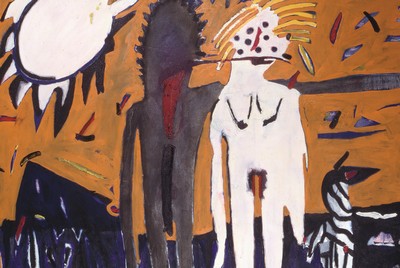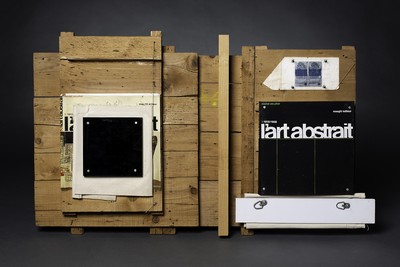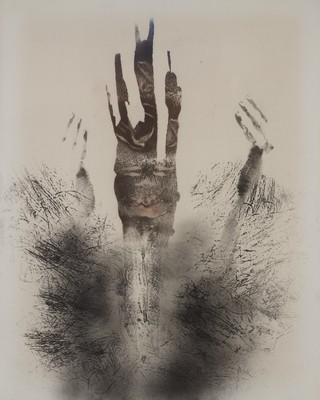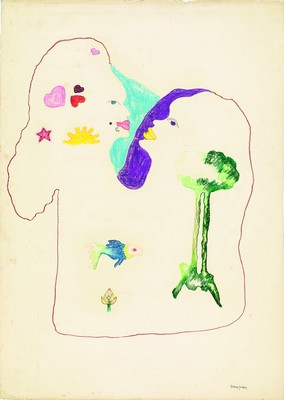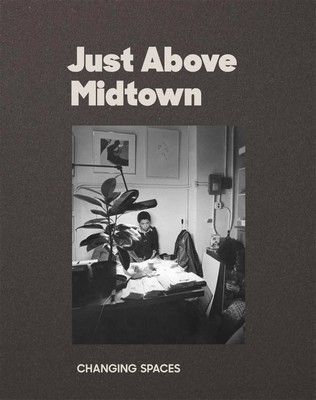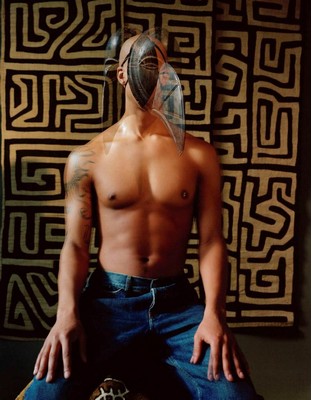Just Above Midtown: Changing Spaces
MoMA, New York
October 9, 2022 - February 18, 2023
Palmer Hayden (American, 1890–1973)
The Subway, c. 1941
Oil on canvas. 30 × 26 in. (76.2 × 66 cm)
The Governor Nelson A. Rockefeller Empire State Plaza Art Collection
George Mingo (American, 1950–1996)
Zebra Couple, c. 1983
Oil on canvas. 48 × 64 in. (121.9 × 162.6 cm)
Courtesy the artist’s estate and Hudgins Family Collection, New York
The Museum of Modern Art presents Just Above Midtown: Changing Spaces.. Just Above Midtown (JAM) was an art gallery and Black space that welcomed artists and visitors of many generations and races in New York City from 1974 until 1986. A hub for Conceptual art, abstraction, performance, and video, JAM expanded the idea of Black art and encouraged both critiques of and thinking beyond the commercialization of art. Linda Goode Bryant started JAM in 1974, when she was a 25-year-old arts educator and mother of two, to, in her words, “present African-American artists on the same platform with other established artists.” A self-declared laboratory for experimentation, JAM encouraged artists and visitors to challenge hierarchies within the art world and definitions of what art should be.
MoMA’s exhibition follows a loose chronological structure that references the hundreds of solo and group exhibitions, performances, and installations at JAM. The display includes a wide range of art made by key figures like David Hammons, Janet Henry, Senga Nengudi, Lorraine O’Grady, Howardena Pindell, and Randy Williams, among many others. The exhibition presents archival photos, videos, and other contextual historical material to give visitors a sense of the collaborative ethos that defined the art gallery and the alternative model of art it championed to respond to a society in need. In addition to the exhibition, the project includes performances, film screenings, public programs, and an exhibition catalogue, co-published with The Studio Museum in Harlem. Just Above Midtown: Changing Spaces is organized by Thomas (T.) Jean Lax, Curator, with Lilia Rocio Taboada, Curatorial Assistant, Department of Media and Performance, in collaboration with Linda Goode Bryant and Marielle Ingram. With thanks to Amber Edmond, Brandon Eng, Curatorial Fellows, and Argyro Nicolau, former 12-month Intern, Media and Performance.
Thomas (T.) Jean Lax explains, “This exhibition recognizes Just Above Midtown as the efflorescent space that modeled how art and the relationships art fosters could respond to a society in crisis. This ambitious project not only historicizes JAM’s importance, but also underscores its relevance in the present.
L’art abstrait, 1977
Wood, canvas, book, book cover, plexiglass, wire, metal bolts, and lottery ticket,
24 × 41 × 5 in. (61 × 104.1 × 12.7 cm).
Courtesy the artist. Photo: Mark Liflander
Untitled, 1976
Grease and pigment on paper
29 × 23 in. (74 × 58.4 cm)
© David Hammons. Hudgins Family Collection, New York
Talk, 1976
Colored pencil on paper 41 1/4 x 29 1/2 inches (104.8 x 74.9 cm)
Courtesy the artist and Ortuzar Projects, New York. Photo: Timothy Doyon
MoMA’s exhibition opens with archival materials that introduce Goode Bryant and JAM to visitors, alongside select artworks that capture the art gallery’s belief in using unconventional and found materials and show the range of styles seen in over 150 JAM exhibitions between 1974 and 1986. Works like Sydney Blum’s SWARMS four (1980), Randy Williams’s L’art abstrait (1977), Valerie Maynard’s The Artist Trying to Get It All Down (c. 1970), and Wendy Ward Ehlers’s Untitled (Three Inches Equals One Week of Laundry) (c. 1974) are presented in tandem with archival documents and photographs from JAM’s opening alongside video footage of Goode Bryant. The interplay of artwork and archive, which visitors experience throughout the exhibition, invites audiences to explore how JAM brought together a community that shared a powerful belief in the ability of artists to use what they had to create what they needed, and to support each other.
The next section of the MoMA exhibition offers a deeper focus on the more than 50 exhibitions that JAM organized from 1974 through 1979. These exhibitions were shown at the gallery's first location at 50 West 57th Street, which was situated in the commercial art gallery district of New York City that was dominated by white gallerists, artists, and buyers. Works on view connect to emblematic group shows at JAM, including its inaugural exhibition, Synthesis: A combination of parts or elements into a complex whole, which presented for the first time Vivian Browne’s painting Untitled (Man in Mountain) (1974) and Norman Lewis’s No. 2 (1973). Synthesis offered a vision of Black art that included and celebrated both figuration and abstraction—a radical departure, at the time, from the broader art world’s status quo of separating those two practices. Visitors also see the pairing of David Hammons’s Untitled (1976) and Jasper Johns’s Hatteras (1963), referencing the show Statements Known and Statements New. This landmark 1976 JAM exhibition juxtaposed works on paper by five widely recognized white artists with works by less established artists of color, to emphasize the importance of creating a desegregated Black space in which non-Black artists show their work, too. The publication Contextures, authored by Goode Bryant and art historian Marcy S. Phillips in 1978, is on view, as well. In Contextures, Goode Bryant and Phillips combined the words “context” and “texture” to create a new concept that referenced artists who questioned the inherent properties of art and used found and remaining materials to create new works of art, while maintaining the integrity of their original form. A loop of archival footage, produced by Randy Williams and Goode Bryant, provides audiences with additional insight into the inventive, experimental process and life at the art gallery.
The corridor gallery provides a window into the behind-the-scenes of JAM's operations, showcasing wallpaper made up of facsimiles of bills, past due statements, and eviction notices. Beginning in 1978 and flourishing at Franklin Street during the early 1980s, JAM ran a professional-development program titled the Business of Being an Artist (BBA) in which JAM staff reviewed individual artists’ work and ran a 33-week course. In 1982, Goode Bryant and video artist Dieter Froese produced and directed a signature film by the same name, seeking support for artist communities beyond New York City and revenue for the gallery through distribution. They interviewed artists, gallerists, curators, and cultural workers about their insider knowledge of the burgeoning contemporary art market, shown as clips in the final work, outtakes of which are on view in this gallery.
As visitors continue through the exhibition, the presentation evolves to focus on JAM’s move downtown, in 1980, to 178–180 Franklin Street. At this location, JAM offered exhibition opportunities to over 500 additional artists and expanded its production of performance, video, and programming—ranging from films to workshops to open rehearsals. JAM continued to organize group shows, often in collaboration with other downtown alternative arts organizations. One of these group shows, Dialogues (1980), was organized with 15 other downtown organizations, including the American Indian Community House and Interart Gallery. Dialogues showcased Hock E Aye Vi Edgar Heap of Birds’s Understanding the Uniqueness of an Ethnic Identity (c. 1980) and Rosemary Mayer’s October Ghost (1980/2022), both of which are on view at MoMA. Performance collaborations brought together artists working across artistic disciplines, including Air Propo (1981), performed by Senga Nengudi, Cheryl Banks-Smith, and Lawrence D. “Butch” Morris. A video of the original performance is on view in the MoMA exhibition.
The last section of the exhibition focuses on the period between 1984 and 1986, when JAM moved to its final physical location in SoHo at 503 Broadway. Here, JAM created a laboratory that specialized in performance, new media, and process-oriented artist support, while subleasing rehearsal and office space to other artist organizations. Visitors see original footage and performance outtakes shot by and capturing artists working at JAM, paired with Lorna Simpson’s Screen 4 (1986) and Sandra Payne’s series Most Definitely Not Profile Ladies (1986). The MoMA exhibition ends with gestures toward the present that speak to JAM’s impact and ongoing legacy, including a diptych by Lorraine O’Grady, Announcement Card 1 (Banana-Palm with Lance) (2020) and Announcement Card 2 (Spike with Sword Fighting) (2020), which serves as a mirror to her first performance at JAM, in 1980, as Mlle Bourgeoise Noire, as well as two new videos by Goode-Bryant
The exhibition continues on the Museum’s fourth floor with Just Above Midtown: To The Present in Gallery 414. This gallery, located within the Museum’s dynamic collection presentation, features Flying Carpet (1990) by David Hammons and a specially commissioned two-channel video, a Negro, a Limo-o (2022) by artists Garrett Bradley and Arthur Jafa and produced by Goode-Bryant that was created in response to her question: how can collaborating with others push artistic limits?
LINDA GOODE BRYANT BIOGRAPHY:
Goode Bryant’s decades of art-based activism began with her founding of Just Above Midtown gallery (JAM), a self-described laboratory that foregrounded the work of African American artists, including David Hammons, Maren Hassinger, Lawrence D. “Butch” Morris, Senga Nengudi, Lorraine O’Grady, Howardena Pindell, and many others. JAM’s explicit purpose was to be “in, but not of, the art world,” offering early—and often unique—opportunities to artists to experiment and create freely, away from art market pressures. After closing JAM, Goode Bryant dedicated herself to filmmaking, directing the Peabody Award–winning documentary Flag Wars (2003), an intimate portrait of a community in flux that explores the tensions between preservation and gentrification. Over her nearly 50-year career, Goode Bryant has and continues to advocate for a connection to “our innate ability to use what we have to create what we need.” Most recently, Goode Bryant founded Project EATS, a “living installation” of neighborhood-based, small-plot, high-yield farms that use art, urban agriculture, partnerships, and social enterprise to sustainably grow and equitably distribute fresh, local, organically grown food in communities across New York City.
EXHIBITION CATALOGUE
Just Above Midtown: Changing Spaces Published by The Museum of Modern Art, New York,
and The Studio Museum in Harlem, 2022
Exhibition Catalogue
A richly illustrated catalogue, published in conjunction with Just Above Midtown: Changing Spaces, showcases rarely seen material from JAM’s history—artworks, ephemera, and photographs—that collectively document the gallery’s communal and programmatic activities. Edited by Thomas (T.) Jean Lax and Lilia Rocio Taboada, it includes essays by Lax and Kellie Jones that contextualize JAM and consider its legacy; a conversation between Goode Bryant and Thelma Golden, Director and Chief Curator of The Studio Museum in Harlem; a complete exhibition chronology written by MoMA and Studio Museum staff with nearly 50 annotated entries; and excerpts from oral histories, conducted especially for this project, with JAM staff and artists. 184 pages, 219 b&w and color illustrations. Paperback with jacket, $45. ISBN: 978-1-63345-137-7. Published by The Museum of Modern Art, New York, and The Studio Museum in Harlem, and available at MoMA stores and online at store.moma.org. Distributed to the trade through ARTBOOK|D.A.P. in the United States and Canada, and through Thames & Hudson in the rest of the world.
Exhibited artists:
Bimal Banerjee (American, born India 1939)
Cheryl Banks-Smith (American, born 1953)
Dawoud Bey (American, born 1953)
Cathey Billian (American, born 1946)
Camille Billops (American, 1933–2019)
Willie Birch (American, born 1942)
Hock E Aye Vi Edgar Heap of Birds (Cheyenne and Arapaho Nations, born 1954)
Sydney Blum (American and Canadian, born 1950)
Garrett Bradley (American, born 1986)
Rolando Briseño (American, born 1952)
Vivian Browne (American, 1929–1993)
Linda Goode Bryant (American, born 1949)
Martin Cohen (American, 1945–2021)
Barbara Chase-Riboud (American, born 1934)
Albert Chong (Jamaican, born 1958)
Houston Conwill (American, 1947-2016)
Charles Daniel Dawson (American, born 1943)
Marcy R. Edelstein (American, born 1950)
Wendy Ward Ehlers (American, born 1929)
Peter Feldstein (American, 1942–2017)
Tom Finkelpearl (American, born 1956)
Susan Fitzsimmons (American, born 1949)
David Hammons (American, born 1943)
Maren Hassinger (American, born 1947)
Palmer Hayden (American, 1890–1973)
Cynthia Hawkins (American, born 1950)
Janet Olivia Henry (American, born 1947)
Suzanne Jackson (American, born 1944)
Walter C. Jackson (American, born 1940)
Arthur Jafa (American, born 1960)
G. Peter Jemison (Enrolled member of the Seneca Nation of Indians, Heron Clan, born 1945)
Noah Jemison (American, born 1943)
Jasper Johns (American, born 1930)
Nina Kuo (American, born 1952)
Norman Lewis (American, 1909–1979)
Rosemary Mayer (American, 1943–2014)
Valerie Maynard (American, 1937–2022)
George Mingo (American, 1950–1966)
Lawrence D. “Butch” Morris (American, 1947–2013)
Jeanne Moutoussamy-Ashe (American, born 1951)
Senga Nengudi (American, born 1943)
Lorraine O’Grady (American, born 1934)
Sandra Payne (American, 1951–2021)
Howardena Pindell (American, born 1943)
Liliana Porter (Argentine, born 1941)
Robert Rauschenberg (American, 1925–2008)
Mallica “Kapo” Reynolds (Jamaican, 1911–1989)
Jorge Luis Rodriguez (American, born 1944)
Betye Saar (American, born 1926)
Raymond Saunders (American, born 1934)
Coreen Simpson (American, born 1942)
Lorna Simpson (American, born 1960)
Russ Thompson (Jamaican, born 1922)
Randy Williams (American, born 1947)
MoMA - MUSEUM OF MODERN ART
11 West 53 Street, New York, NY 10019


